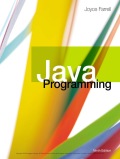
Concept explainers
a.
Explanation of Solution
Program:
File name: “Purchase.java”
//Define a class named Purchase
public class Purchase
{
//Declare the private variables
private int invoiceNumber;
private double saleAmount;
private double tax;
private static final double RATE = 0.05;
//Define a set method for the invoice number
public void setInvoiceNumber(int num)
{
invoiceNumber = num;
}
//Define a set method for the sale amount
public void setSaleAmount(double amt)
{
//Calculate the sales tax as 5% of the sale amount
saleAmount = amt;
tax = saleAmount * RATE;
}
�...
b.
Explanation of Solution
Program:
File name: “CreatePurchase.java”
//Import necessary header files
import javax.swing.*;
//Define a class named CreatePurchase
public class CreatePurchase
{
//Define a main method
public static void main(String[] args)
{
//Declare Purchase object
Purchase purch = new Purchase();
//Declare the variables
int num;
double amount;
String entry;
final int LOW = 1000, HIGH = 8000;
//Prompt the user to enter the invoice number
entry = JOptionPane.showInputDialog(null, "Enter invoice number");
num = Integer.parseInt(entry);
/*While the user does not enter a number between 1,000 and 8,000*/
while(num <= LOW || num >= HIGH)
{
//Print the message
entry = JOptionPane.showInputDialog(null, "Invoice number must be between " +
LOW + " and " + HIGH + "\nEnter invoice number");
num = Integer...
Want to see the full answer?
Check out a sample textbook solution
- a) Show a possible trace of the OSPF algorithm for computing the routing table in Router 2 forthis network.b) Show the messages used by RIP to compute routing tables.arrow_forwardusing r language to answer question 4 Question 4: Obtain a 95% standard normal bootstrap confidence interval, a 95% basic bootstrap confidence interval, and a percentile confidence interval for the ρb12 in Question 3.arrow_forwardusing r language to answer question 4. Question 4: Obtain a 95% standard normal bootstrap confidence interval, a 95% basic bootstrap confidence interval, and a percentile confidence interval for the ρb12 in Question 3.arrow_forward
- The assignment here is to write an app using a database named CIT321 with a collection named students; we will provide a CSV file of the data. You need to use Vue.js to display 2 pages. You should know that this assignment is similar, all too similar in fact, to the cars4sale2 example in the lecture notes for Vue.js 2. You should study that program first. If you figure out cars4sale2, then program 6 will be extremely straightforward. It is not my intent do drop a ton of new material here in the last few days of class. The database contains 51 documents. The first rows of the CSV file look like this: sid last_name 1 Astaire first_name Humphrey CIT major hrs_attempted gpa_points 10 34 2 Bacall Katharine EET 40 128 3 Bergman Bette EET 42 97 4 Bogart Cary CIT 11 33 5 Brando James WEB 59 183 6 Cagney Marlon CIT 13 40 GPA is calculated as gpa_points divided by hrs_attempted. GPA points would have been arrived at by adding 4 points for each credit hour of A, 3 points for each credit hour of…arrow_forwardI need help to solve the following case, thank youarrow_forwardhi I would like to get help to resolve the following casearrow_forward
 EBK JAVA PROGRAMMINGComputer ScienceISBN:9781337671385Author:FARRELLPublisher:CENGAGE LEARNING - CONSIGNMENT
EBK JAVA PROGRAMMINGComputer ScienceISBN:9781337671385Author:FARRELLPublisher:CENGAGE LEARNING - CONSIGNMENT EBK JAVA PROGRAMMINGComputer ScienceISBN:9781305480537Author:FARRELLPublisher:CENGAGE LEARNING - CONSIGNMENT
EBK JAVA PROGRAMMINGComputer ScienceISBN:9781305480537Author:FARRELLPublisher:CENGAGE LEARNING - CONSIGNMENT Microsoft Visual C#Computer ScienceISBN:9781337102100Author:Joyce, Farrell.Publisher:Cengage Learning,
Microsoft Visual C#Computer ScienceISBN:9781337102100Author:Joyce, Farrell.Publisher:Cengage Learning, Programming with Microsoft Visual Basic 2017Computer ScienceISBN:9781337102124Author:Diane ZakPublisher:Cengage LearningProgramming Logic & Design ComprehensiveComputer ScienceISBN:9781337669405Author:FARRELLPublisher:Cengage
Programming with Microsoft Visual Basic 2017Computer ScienceISBN:9781337102124Author:Diane ZakPublisher:Cengage LearningProgramming Logic & Design ComprehensiveComputer ScienceISBN:9781337669405Author:FARRELLPublisher:Cengage




